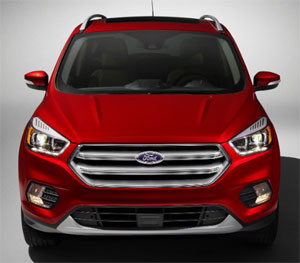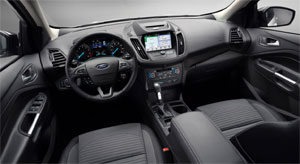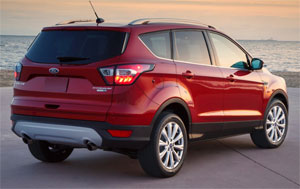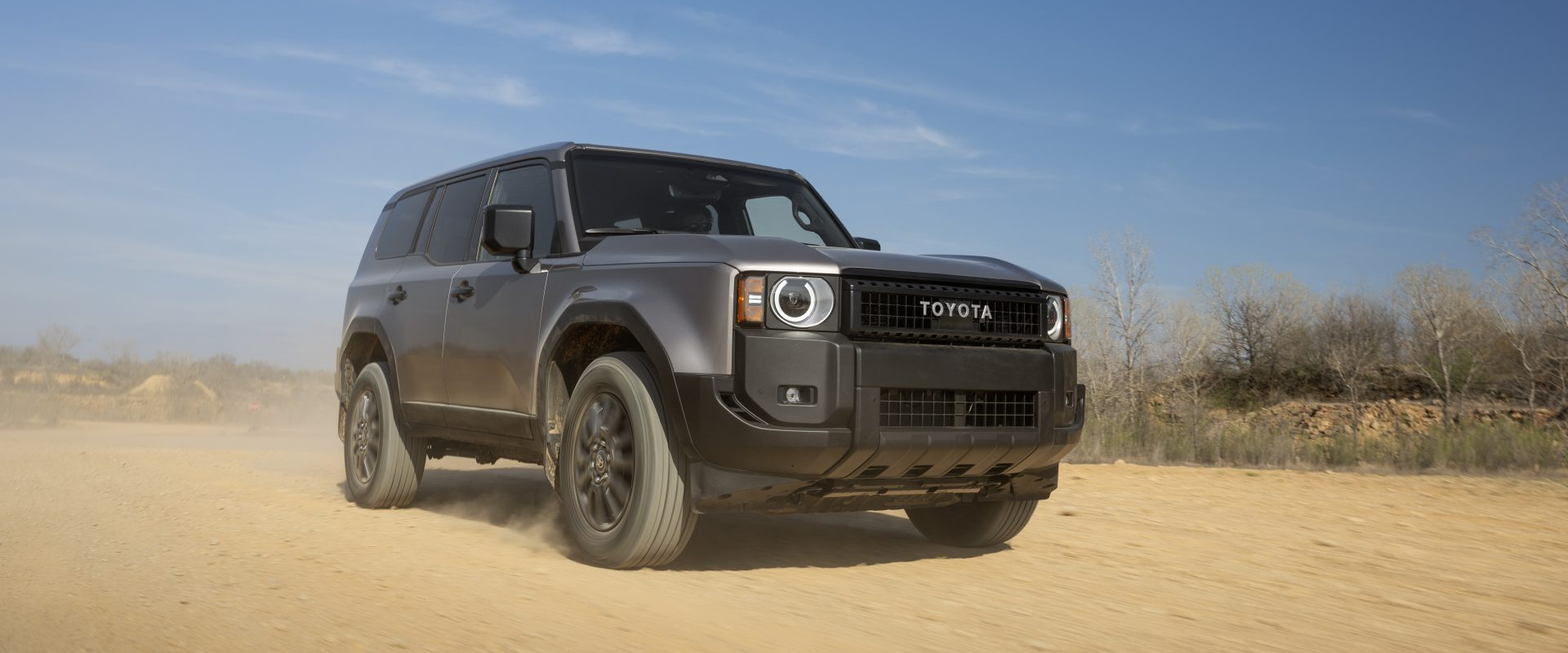2017 Ford Escape
Nothing’s hotter than small crossovers right now. So Ford probably could have kept business as usual for their compact Escape and been just fine, as they sold over 300,000 of them in the U.S. last year. But that’s not how things work at Ford these days, or the auto industry in general; so for 2017, a freshened Escape drives into the scene.
Ford certainly gives you plenty of powertrain options.
Base S Escape’s come with a normally aspirated 168-horsepower 2.5-liter I4; in front-wheel-drive only. SE and Titanium trims comes with Ford’s 1.5-liter EcoBoost with 179-horsepower and all-wheel-drive is available.
 Also optional, is this 2.0-liter EcoBoost which rates 245-horsepower and a stout 275 lb-ft. of torque. All engines work with a 6-speed automatic transmission; max towing is good for the compact class, at 3,500-lbs.
Also optional, is this 2.0-liter EcoBoost which rates 245-horsepower and a stout 275 lb-ft. of torque. All engines work with a 6-speed automatic transmission; max towing is good for the compact class, at 3,500-lbs.
The 2.0-liter feels plenty peppy on the street with gearing clearly designed for acceleration. We actually got complaints of this being too much engine for this vehicle; highly unusual from our power-hungry crew. But that was mostly due to the overachieving stability system. It becomes very problematic when attempting a strong launch, finding the balance between too much control and too much wheelspin with it turned off. It feels faster than the 7.6-seconds it took us to hit 60; especially, as once the transmission hits 2nd and gets good traction it really takes off.
Shifts are very smooth; but even in Sport mode, a touch slow for our tastes. We finished out the ¼-mile in 16.0-seconds flat at 85 miles-per-hour.
Through our handling course, it was light and agile; comfortable and solid for a compact ute.
A 107-foot average for braking from 60 is quite good; but there’s a very artificial feel to the pedal, and some aggressive pulling to the side on initial braking, keeps the results from being perfect.
Speaking of stopping, the Escape adds a new standard stop/start system with all EcoBoost engines, and we found it to work quite smoothly.
 Changes to the interior of the newest Escape consist mostly of a reconfigured center console, that swaps the big parking brake handle for an electronic switch, moving the shifter back for easier access to lower stack controls, and for plugging things into the USB port and power outlet. Wrapping the revisions up inside, is a new steering wheel with revised switchgear.
Changes to the interior of the newest Escape consist mostly of a reconfigured center console, that swaps the big parking brake handle for an electronic switch, moving the shifter back for easier access to lower stack controls, and for plugging things into the USB port and power outlet. Wrapping the revisions up inside, is a new steering wheel with revised switchgear.
Seating is a “tale of two spaces” with abundant room and coziness for those in front, but marginal legroom and comfort for rear seat passengers.
Forward collision warning, as well as lane-keeping are available, but not autonomous braking.
The new Escape looks physically bigger, due to a taller grill and redesigned hood that also gives it a friendlier, less aggressive tone.
Not much else changes outside. A hands free power lift gate is optional; and behind it you’ll find a decent 34.0 cubic-ft. of cargo space, maxing out at 68.0 with the rear seatbacks folded.
 Government Fuel Economy Ratings for our front-wheel-drive 2.0-liter are 22-City, 29-Highway, and 25-Combined. Our average was almost right on at 24.5 miles-per-gallon of Regular.
Government Fuel Economy Ratings for our front-wheel-drive 2.0-liter are 22-City, 29-Highway, and 25-Combined. Our average was almost right on at 24.5 miles-per-gallon of Regular.
Escape pricing falls right in line with the rest of the segment, starting at $24,645; and reaching into the low 30s. All-wheel-drive costs $1,750 more.
With an all-new and terrific Honda CR-V, and better-selling-than-ever Nissan Rogue on the prowl, we applaud Ford for seeing that meaningful mid-cycle changes were critical for the 2017 Ford Escape’s success. It is now about as techno-savvy as the compact utility segment gets, and certainly a fine choice in the ever-more crowded crossover world.
Specifications
- Engine: 2.0 liter
- Horsepower: 245
- Torque: 275 lb-ft.
- 0-60 mph: 7.6 seconds
- 1/4 mile: 16.0 seconds @ 85 mph
- EPA: 22 mpg city / 29 mpg highway
2024 Toyota Land Cruiser
Toyota’s Go Anywhere Globetrotter Returns To U.S.
Every once in a while, we all need a reset. A time to get back to basics and prioritize the things that really matter. Well, for the Toyota Land Cruiser that time is now. So, let’s find out if that means bigger and better things for Toyota’s iconic off-roader.
The Toyota Land Cruiser’s status among the global off-road community is legendary, and it’s hard to imagine there’s any corner of the earth where a Land Cruiser hasn’t kicked up a little dust or mud. Well, 2024 sees the return of the Land Cruiser to the U.S. market after a 3-year hiatus, getting a major reset for the journey.
The reset comes mostly by no longer being based on the large three-row “300-series” chassis, but a new version of the smaller “200-series,” now known as the J250. As with the latest Tacoma, it uses the Tundra pickup’s full-size steel frame.
While the main Land Cruiser model, which goes by simply Land Cruiser, is packed full of luxury and convenience features, there is also a stripped-down model known as the 1958, honoring the first year the Land Cruiser made landfall here in North America. And it is that 1958 we have here, and we were glad to see it, as it also celebrates the original’s back-to-basics approach as a blank canvas for you to personalize as you tackle more and more adventures.
Not that it’s fully stripped down, as 8-inch touchscreen infotainment, a 7-inch full-color multi-information display, and automatic climate control are still standard. Plus, some seriously durable materials, and great heated cloth front seats that throw off some get serious 1990s Tacoma vibes.
But outside, there’s a definite lack of flashy trim and basic looking 18-inch wheels with Yokohama Geolander all-season tires; plus, big chunky bumpers and tilt-up back glass, which is a rarity that we appreciate. Though there is a little too much plastic in places that are sure to see some abuse if you do any significant off-roading.
It even feels a little rough around the edges, but for us it just adds to the rugged old-school utility vibe in a good way.
We did just that, both here in the Mid-Atlantic as well as in the California desert; and while there are some tech-forward driving aids, the actual hardware is in most cases plenty to get things done. That includes standard full-time dual-range four-wheel-drive, locking center and rear diffs, and 8.7-inches of ground clearance. A front stabilizer bar disconnect is also available to allow for increased articulation.
Who needs a V6 or even a V8 when you’ve got Toyota’s i-FORCE MAX setup at your disposal with 326 horsepower and 465 lb-ft of torque coming from a 2.4-liter turbo-four with an electric motor sandwiched between the engine and its eight-speed automatic transmission. Low speed torque delivery is impressive. It even feels a little rough around the edges, which may be a turn off to some, but for us it just adds to the rugged old-school utility vibe in a good way.
And it certainly feels quicker than an off roader needs to be, with an instant torque dump as soon as we eased on the throttle at our Mason Dixon test track; helping us get to 60 in 8.1 seconds and through the quarter-mile in 16.3 seconds at 86 mph. Considering the Land Cruiser’s terrain conquering mission, it behaved quite well in our handling course; it was plenty responsive to inputs, with less body roll than we expected and plenty of grip from the tires. The steering was light and quick but as expected didn’t provide much feel. Other than significant nosedive, braking performance was exceptional. Only 107-feet to panic stop us from 60 mph.
With the shift to the smaller size, there’s no more third row available, and cargo capacity now comes in at 46.2 cubic-feet with a max of a still healthy 82.1. Now, the best part of the Land Cruiser’s return is the entry price of $57,445. That’s about 30-grand less than what the last Land Cruiser went for back in 2021.
Whether it’s over the top fashion trends, mullets, or zombies; just when you think they’re dead, they come roaring back to life. Of course, we’re much happier to see the resurrection of this 2024 Toyota Land Cruiser than any of those things. Toyota is one brand that still recognizes the value of full-framed rugged rigs and has also acknowledged that sometimes less really is more. The Godfather of Toyota off-roading is back and better than ever.







